Dormie Club
North Carolina, United States of America
Please note: all photographs in this profile were taken between November and February. While North American clay-based courses labor to provide good golf in that time frame, the Sandhills of North Carolina thrives, especially at places like Dormie that don’t overseed.
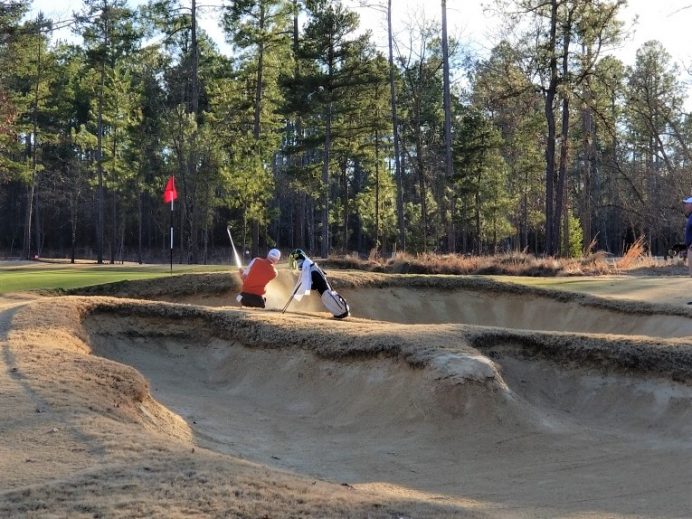
Entering its tenth year, things have never looked brighter for Dormie.
The concept of lay of the land architecture seems simple yet entails much. One of the best at it was Alister MacKenzie, who seemed to show up at each project with a fresh set of eyes. There is Cypress Point, whereby MacKenzie unearthed as many fine holes as possible in part because he didn’t return the nines and anomalies were allowed to exist, including back-to-back par fives, back-to-back short par fours and back-to-back par threes. A year later, Pasatiempo opened and MacKenzie’s use of a barranca on the second nine is a master class, culminating with a final carry across one at the finishing hole, which is unusual in that it is a par three. And of course, his work at Augusta National may well be the epitome of lay of the land architecture as the tilting broad slopes and wild greens define much of the challenge, as opposed to bunkers (of which the course opened with a mere twenty-two). Yes indeed, be it embellishing the sandy qualities of a site like Cypress Point or routing holes around a natural feature or incorporating sweeping land forms into holes, MacKenzie made something difficult look easy.
Same can be said for Bill Coore, who we find tromping around in the woods north of Pinehurst in 2005. Coore, whose favorite architect and course are Alister MacKenzie and Cypress Point, was figuring out how to best utilize the property’s dominant components. Happily, the majority of the property revealed itself to be sand based, a huge plus. Second, hardwoods were more prevalent here than elsewhere in Moore County. Third, the land consisted of broad slopes as opposed to rippling, humpy bumpy land forms. Fourth and problematically, wetlands and their fingers proliferated. Without an efficient routing, the owners could go broke building bridges.
Days turned into weeks as Coore mulled over the countless permutations in finding a course over the 1,200 acres. Coore followed the deer trails on this former hunting ground to glean the path of least resistance across the sloping, rugged land. Though the obvious comparison might be with Pine Valley because of the sandy floor and hardwoods, Coore was reminded more of Oakmont with its broad sweeps. The wild card though remained the wetlands. A number of shots would need to cross them and their feeder creeks.
Surprisingly enough, Coore’s initial routing was completed prior to the county delineating the wetlands. Coore reflects, ‘In coming up with the routing, we were free to place the golf where it best belonged. Naturally, we looked for a mix of shots but we were always cognizant of the merits of playing from high point to high point and being leery of getting too close to any areas (wetlands or not) that would prove problematic from a drainage perspective. We felt comfortable in pursuing this path because the land features were so strong that it was evident where the golf did – and didn’t – belong.’
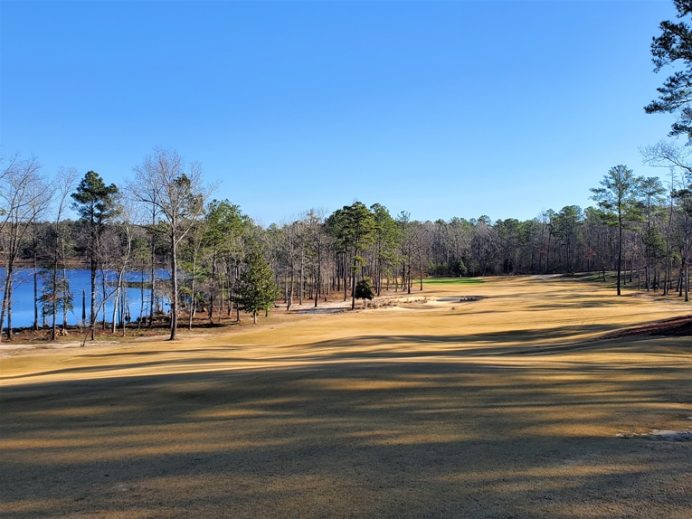
The biggest lake on the property is left of the 8th fairway. Plenty of architects would have strung a hole along it. What did Coore & Crenshaw do? Swung the fairway right toward high ground.
Though completing a routing before having the no-go area of the wetlands identified is highly unusual, that’s what occurred. When Coore was ultimately handed the map with the state’s red markings outlining the wetlands, he was stunned. A staggering percentage was in red and Coore says to this day, ‘If I had known from the start just how much of the property was wetlands, we would have passed on the project.’ Imagine that! Yet as it was, his routing and his gut instinct for sticking to higher land meant that little needed to be altered. There was one notable exception and that occurred at the tenth, to be discussed under Holes to Note.
Since their beginnings in the 1980s at Kapalua Plantation, Coore & Crenshaw have established an admirable history of avoiding forced carries either by allowing fairways to swing wide around ravines or affording the golfer the perfect stance and lie to tackle a forced carry by having him do so from the tee (e.g. the eighth at Kapalua). That design philosophy has stood them in good stead and helps explain why their courses are a delight for all levels of players. So it proved here at Dormie. Pronounced carries over wetlands are required from the second, third, fifth, seventh, fifteenth, and seventeenth tees. The golfer doesn’t mind – or necessarily even notice – because they all occur from the safety of the tee.

Though this handsome bunker is well positioned on the inside of the dogleg left at the 2nd, the star of the hole is …
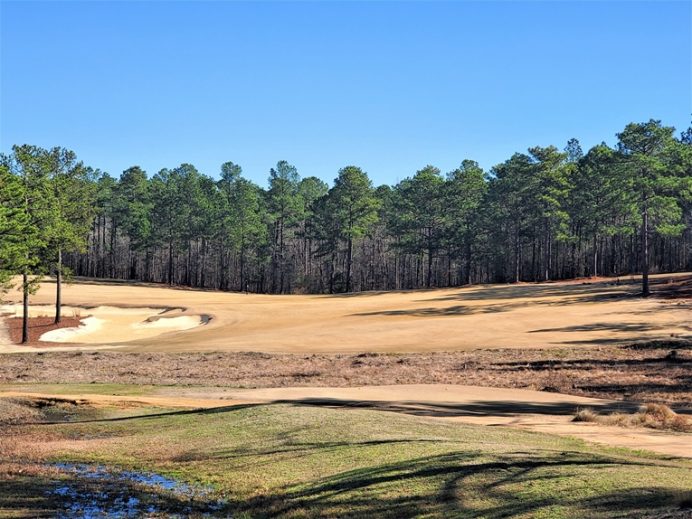
… the tilt of the land and the manner in which Coore & Crenshaw incorporated it into the playing aspects of the hole, all while disturbing little dirt from tee to green.
Consistent with lay of the land architecture and an architect unwilling to contort the land, the pacing at Dormie proved to be unusual. The course opens with five par fours followed by a par five. The first par three isn’t until the seventh and even then, it is a burly one at that. The course’s hardest par then follows at the eighth and just when the golfer’s fragile ego is feeling bruised, the hardest par 5 Coore & Crenshaw have ever built rears its head at the tenth. Well! More than one pity party has been had on the walk from ten green to eleven tee and standing on the tee, the golfer is now the farthest point from the clubhouse.
If a slew of hard holes brought the golfer home, one could dismiss the course for being a bully and characterize it as being too difficult. Any architect could produce such an outcome but you hire Coore & Crenshaw precisely for the opposite reason: to produce a course that one yearns to play time and time again. So … what happens? On the journey in, the golfer plays one of their shortest one shotters ever at 110 yards, a drivable par four with but one bunker and a reachable par five. Heroics in the form of eagles exist at all three of these 1/2 par holes.
The unusual sequence of holes is interesting from a pacing perspective. In January, our group of four took one hour and fifty minutes to play holes 1-8. Yet to play one third of the course (i.e. holes 7-12 ) took less than one hour as three of those holes are par threes. We finished the round in just over three hours and thirty minutes, well ahead of the pace we were on after eight holes. Though no architect ever sets out to build the longest/hardest par three, par four and par five in a four hole stretch, that is what Coore & Crenshaw landed on at holes seven, eight and ten at Dormie. Yes, it’s a bruising stretch but opportunities abound on both sides.
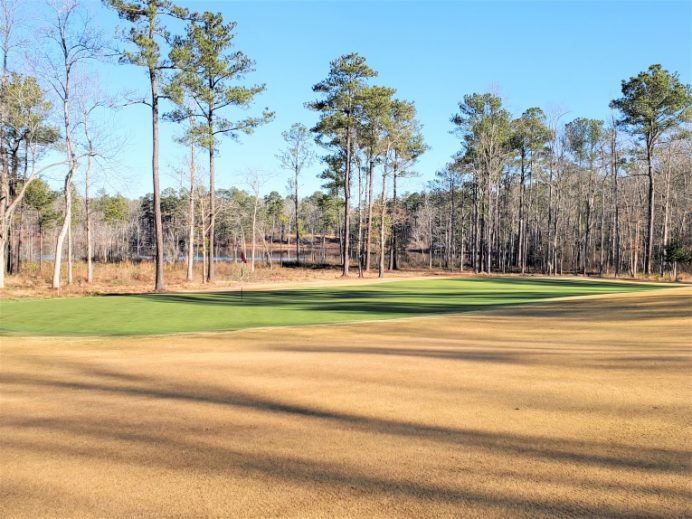
The range in size and configuration of the greens at Dormie is outstanding. The 8th green (seen above) measures 51 yards long but is only half as wide. At nearly 8,700 square feet, it is the course’s third largest green and joins the 1st and 2nd greens in being bunkerless.
One tip that locals share: Being cognizant of the interaction between the broad slopes and wetlands serves the player well. Take the fifth and eighth holes as prime examples (and note how well they complement each other). At the fifth, the golfer has a lengthy forced carry over the edge of the lake which peels along the right of the fairway. No surprise that the perfect lie of a ball on a peg is provided. Rainwater seeks the lake and so the player is well advised to aim for the high, left side of the fairway, which is drier and firmer than the lower, flat side by the lake. The difference in run out from a tee ball hit high left vs low right can be a club or two into the green.
Same for the eighth, though the situation is mirrored. The broad sweep of the property from high right to low left moves copious amounts of rainwater across it toward the property’s largest lake. The eighth fairway was a bear during construction with several severe storms proving just how much rainwater would relentlessly seek to cross the fairway. French drains and berms were installed but the playing strategy remains to use the high land to your advantage to obtain the most roll.
Before heading out onto the course, another lay of the land aspect should be noted. Though Coore & Crenshaw became famous for building some of the greatest hazards in the modern game at places like Sand Hills, Friar’s Head and Old Sandwich, there are five holes at Dormie that are bunkerless off the tee (e.g. the fifth, eighth, tenth, thirteenth and fourteenth). All feature slopes and the lack of bunkering speaks to Coore’s desire to have the land tell the story, as we see below.
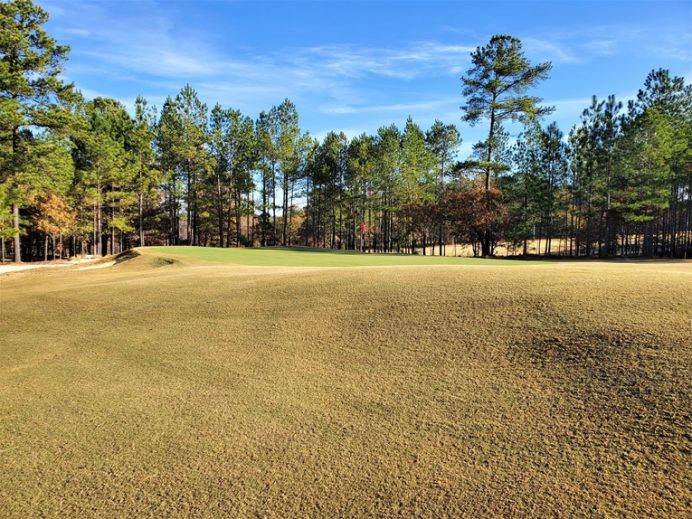
Other Coore & Crenshaw designs are more heavily bunkered. Here with the sandy soil providing optimum drainage, Coore stuck more with slopes and depressions (like this one short left of 6) to challenge the player.
Holes to Note
First hole, 420 yards; With Pinehurst No. 2 a scant five miles away, the last thing that Coore & Crenshaw wanted was to somehow be in a design competition with Donald Ross’s masterpiece. Dormie needed to have its own voice, which given how wildly different the two properties are, was never going to be an issue. Still, one crown green at Dormie would send eyeballs rolling. Standing on the first tee, the two courses couldn’t be more different. At Dormie, a pleasingly downhill tee ball greets the golfer and is followed by an approach to a green glued to the ground with punchbowl qualities around the rear and sides. At Pinehurst No. 2, the opener features its typical demure topography followed by the first of eighteen infamously upturned saucer greens, shedding balls in every direction. The author thinks it was a master stroke to establish at the outset that Dormie was never going to be some sort of ‘Pinehurst No. 2-lite’ playing experience. At over 9,200 square feet, this gathering green is the day’s largest target and helps to get play away smoothly.
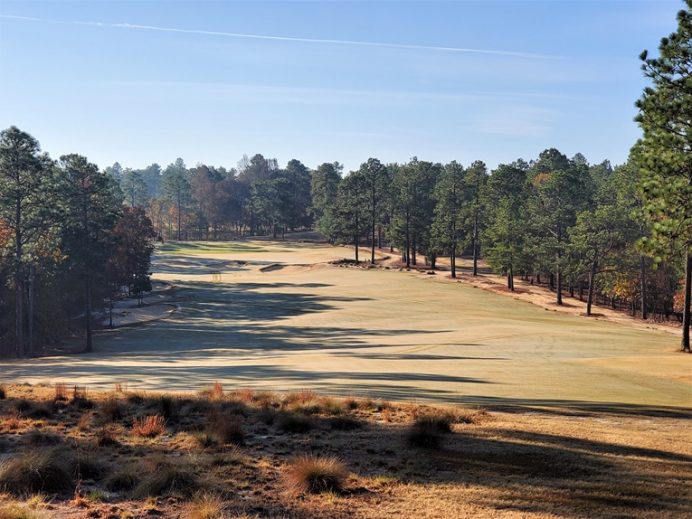
The pleasing vista from the 1st tee.
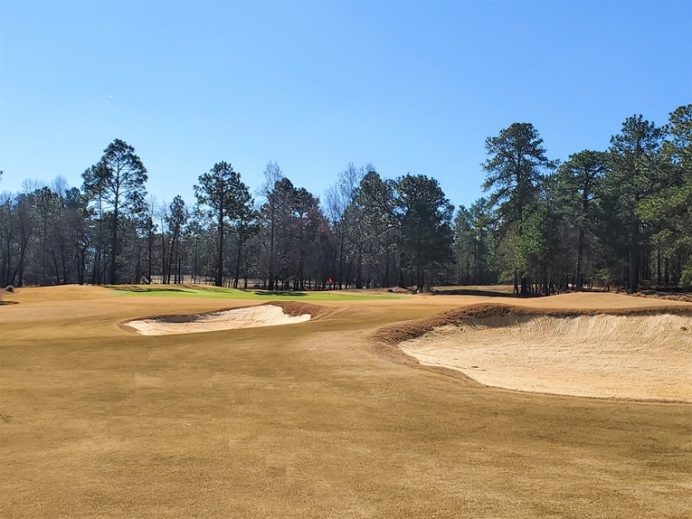
The green is an extension of the fairway and is set in a sea of short grass.
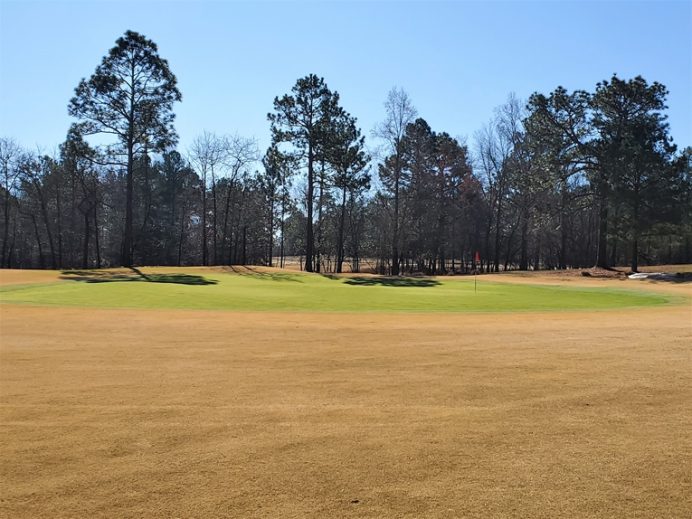
A common sight at Dormie is a green completely open across the front. Does that mean the architect was keen to encourage ground game options? You bet.
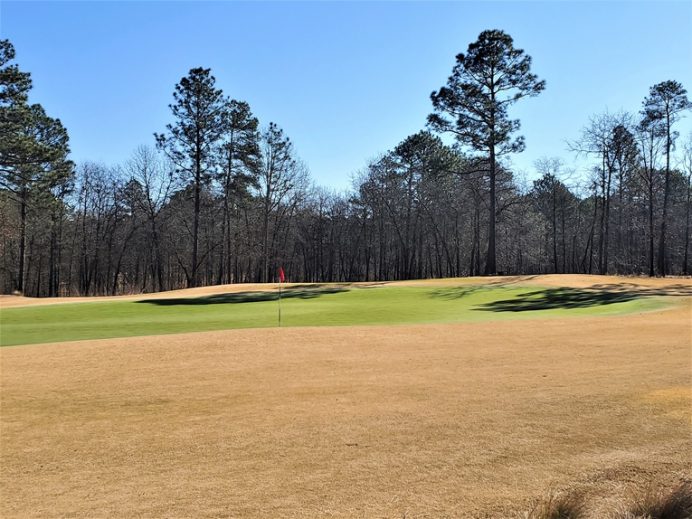
This side view from the right shows how the green complex is actually a saucer (low in the middle and high on the sides) versus Pinehurst No.2’s infamous inverted saucer greens (high in the middle and soft on the sides).
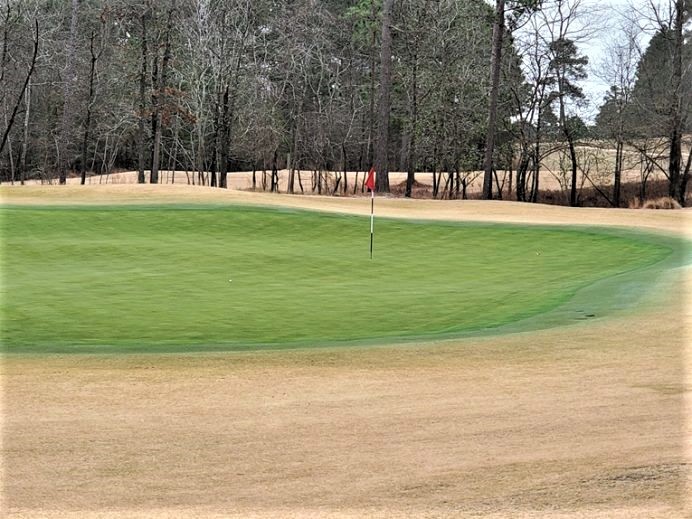
It is all about the ground at Dormie. To avoid the false front, a good play to back hole locations like this one is to be long and let the ball feed off the rear slopes.
Third hole, 310 yards; The first three holes highlight both the opportunities and challenges that faced Coore & Crenshaw. Indeed, the third green is but a flick wedge from the first tee. In the space of these holes, the golfer gains an appreciation of the sandy soil, the hardwood trees and the rolling, almost hilly, topography. He also appreciates how the low points are occupied by wetlands and creeks and how tricky it surely was to string eighteen holes together, one after another, and have the course remain walkable and fun.
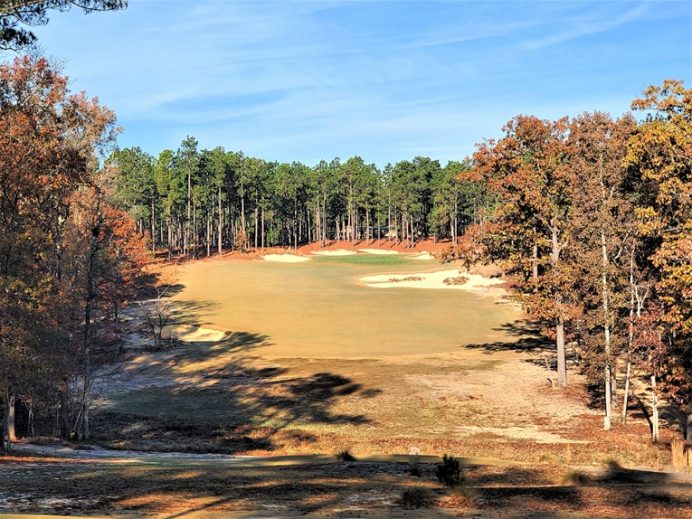
Coore & Crenshaw often use short two shot holes to handle ticklish routing situations and to transport the golfer higher on the property. Such is the case at the straightaway 3rd.
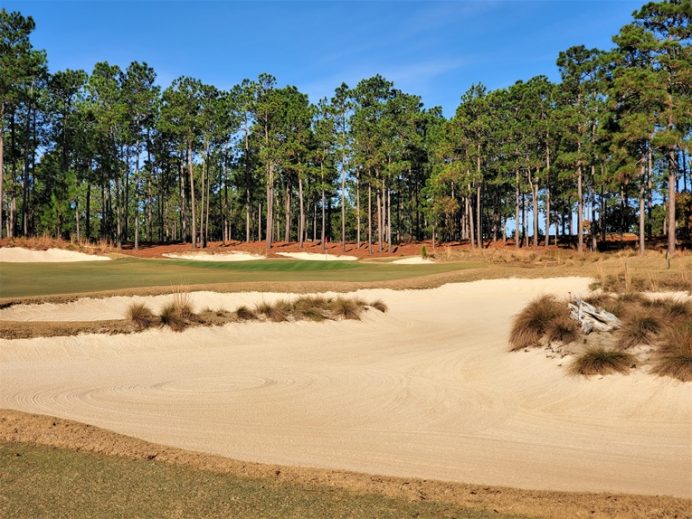
A large bunker 25 yards in length protrudes from the right. Rather than wrangle with it, most members have decided to pick a club off the tee that keeps the tee ball just short.
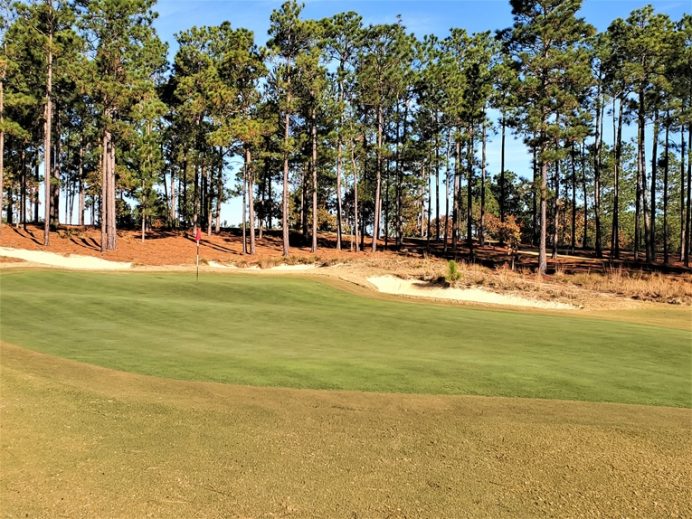
The green is the most convoluted on the course, befitting a hole of this length. The back hole locations are difficult to access while …
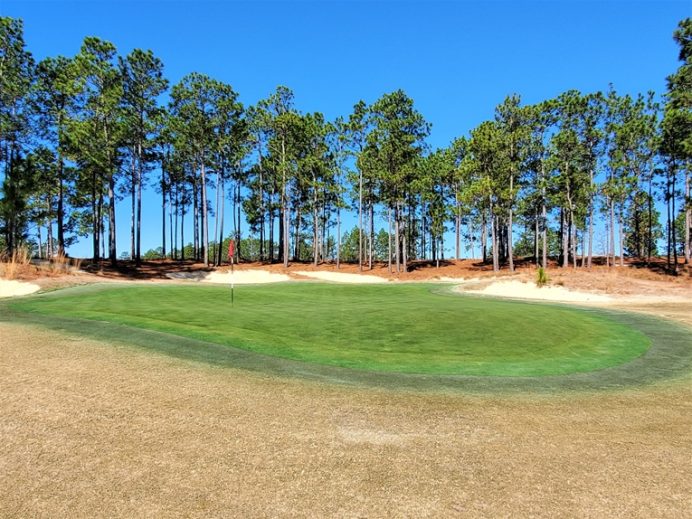
… the forward ones can be quite fun as balls that hit in the middle take the contours and peel back to the front hole locations. On a more tragic note, a ball with too much juice can also hit 8 paces on and end up 25 yards (!) back in the fairway.
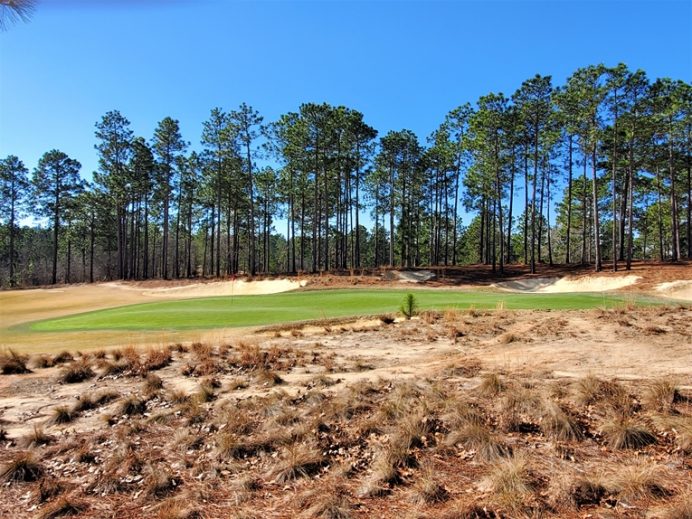
Add up all its features and Canadian golf course architect Ian Andrews considers the 3rd to be one of the best greens he has seen in modern times.
Fourth hole, 435 yards; As we enter a new decade in 2020, reality sets in that this is likely the last decade that will produce original works from Coore & Crenshaw. They started their partnership with a BANG at Kapalua Plantation in 1986 and have set a design standard since. The value of their cumulative body of work speaks for itself but how to judge the merit of their individual projects against one another? One simple way is to come up with their eclectic 18 holes. If the course you are considering has multiple candidates to join holes from the likes of Sand Hills and Friar’s Head, then you are dealing with something special. Without doubt, the fourth and fifteenth from Dormie make such a compilation by the author. In the case here, a draw off the tee and a fade into the green makes the fourth a superlative switchback hole. Though the young bomber might not shape the ball like the old trooper, this kind of old fashioned golfing value is a perfect fit and complement to the greater Pinehurst area where golf has been played for 125 years.
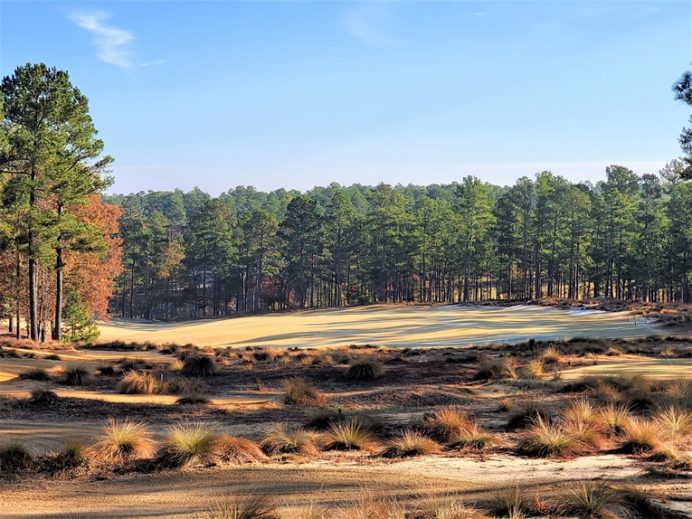
A draw toward the outside of the dogleg works wonderfully and sets up …
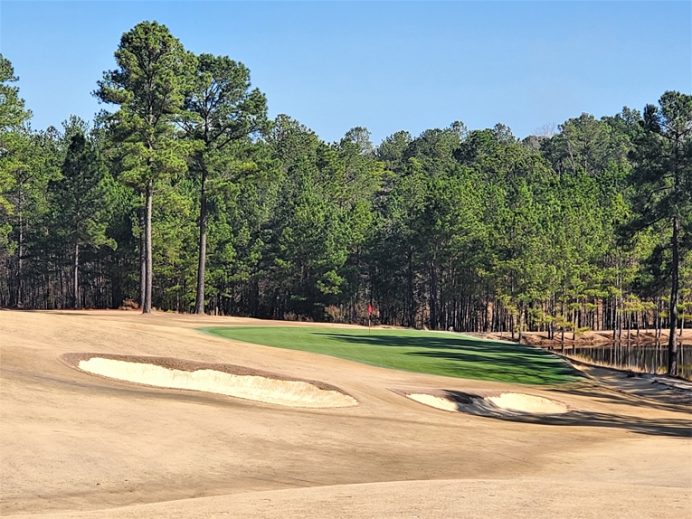
… this approach shot. One of the course’s most joyous shots is seeing a fade deaden off the left hillside, releasing the ball on a slow trickle onto the putting surface. The miss is long as the pronounced false front discards anything short.
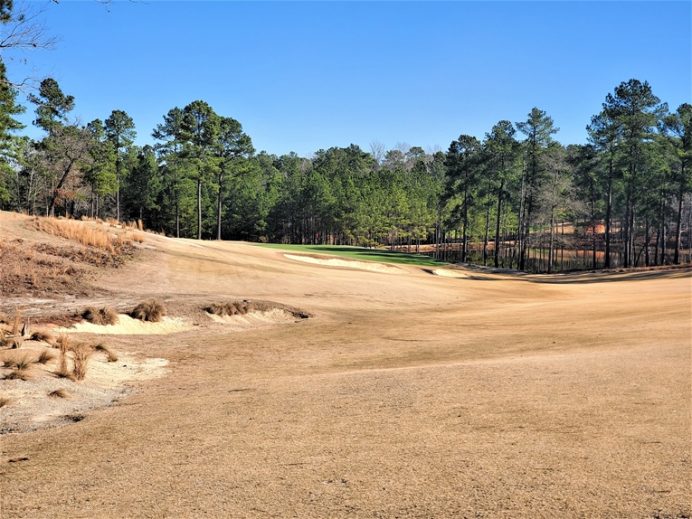
Don’t be too greedy and hug the inside of the dogleg as lands shoves tee balls toward this nest of bunkers that are unseen from the tee.
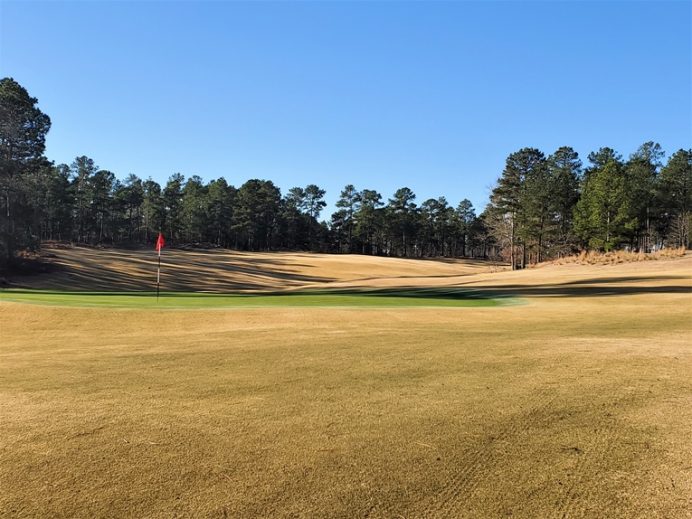
The gorgeous view from behind captures the fairway’s right to left bank in the distance followed by the greenside’s left to right bank. Grade A+ lay of the land architecture.
Fifth hole, 430 yards; Nobody builds handsomer bunkers than Coore & Crenshaw and they have done so for several decades. Therefore, it is always a delight to stumble across holes with a dearth of bunkers. That’s right – an absence of bunkers signifies that something else is at play and so it is at the fifth where the land’s tilt is the star. The photographs below also highlight one of the joys of fall/winter golf in the Sandhills of North Carolina: dormant Bermuda. Like Pinehurst No.2 and Pinehurst No.4, Dormie doesn’t overseed with rye. Dormant Bermuda releases the ball unlike rye, which, though its appealingly green color contrasts well against the sandy floor, plays too sticky. The ball’s release is especially crucial at a lay of the land course like Dormie, where so much of the playing strategy is derived from using the land to your advantage.
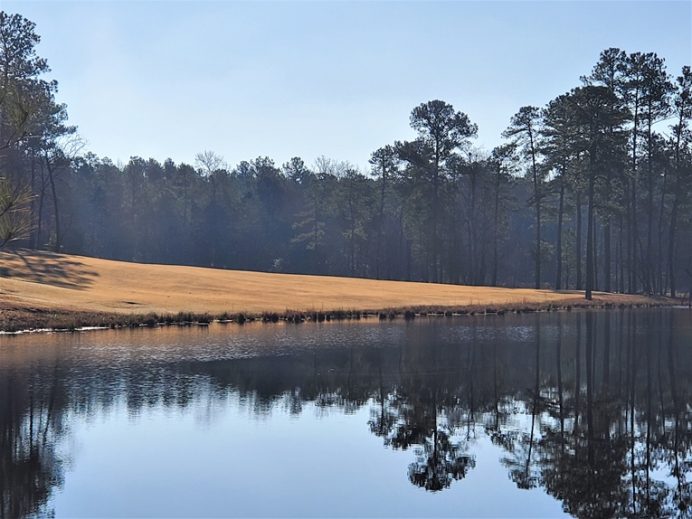
The fifth is a study in how not to clutter a hole with superfluous features. Note how the broad left to right slope was left untouched. The ideal tee ball is a power fade up the left as the high ground guarantees the firmest bounces forward.
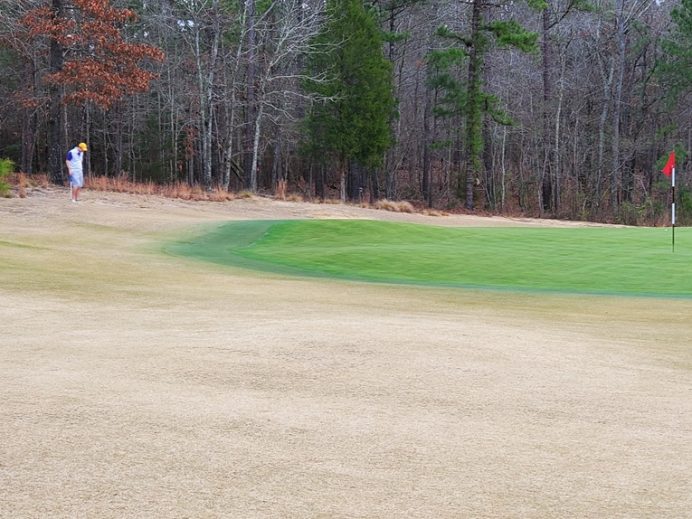
The green also plays off the dominant theme of the land, featuring a kick mound high left and then another step down in the middle of the green that ultimately concludes with a lower right section. A fronting bunker would have added nothing.
Sixth hole, 525 yards; The merit of some holes is obvious from the get go as a visual excitement is matched by playing qualities. At Dormie, examples include the fourth, fifteenth and seventeenth. Other holes grow on a golfer over time via trial and error. Generally, such holes are more muted in appearance but their golf quality is so high that admiration eventually follows. Such are the sixth and fourteenth. Yes, the uphill tee shot holds drama but once one crests the hill, the fairway provides an uninterrupted, linear path to the green. Where is the challenge in that? Play it enough and you’ll find out! Dormie’s talented Green Keeper Billy Lewis states, ‘Both our sixth and fourteenth holes are the easiest double bogeys that you will ever make and also the easiest birdies with two good shots.’

The enticing uphill blind tee shot at the 6th is followed by …
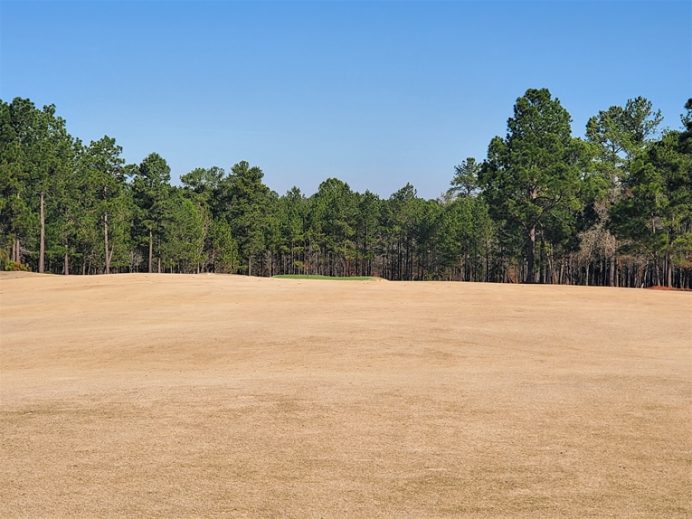
… a seemingly innocuous second shot with no apparent danger.
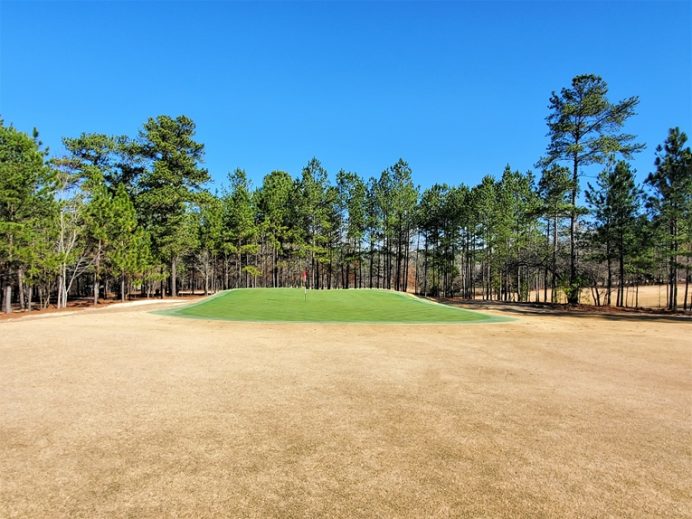
The trouble lies in not knowing there is trouble! Two things aren’t readily apparent, even standing this close to the green. First, the green slopes from front to back and second, at 4,659 square feet, it is the course’s second smallest target.

This side view captures how the peninsula green starts at fairway level and as it recedes, becomes higher from its surrounds.
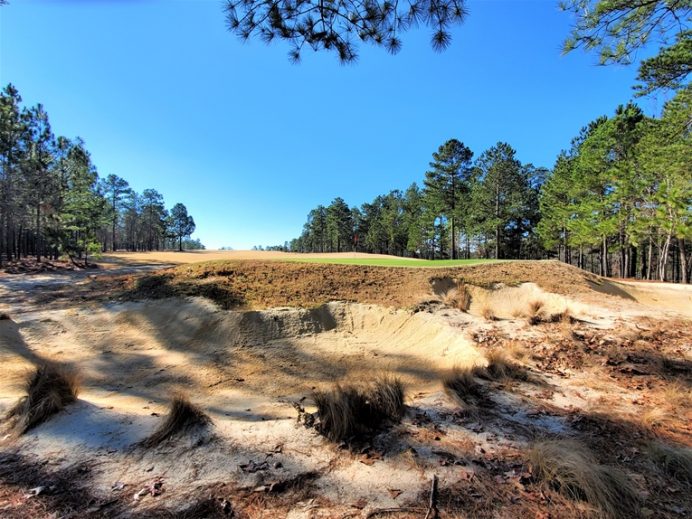
This view from behind makes the hole’s hidden dangers more apparent. Note how the putting surface follows the slope of the land as well as how narrow the green becomes toward the rear. The small size of the bunkers replicate the playing problems of pot bunkers in the United Kingdom in that the golfer will need to get the ball up quickly but he is not guaranteed either the stance or swing to do so.
Seventh hole, 235 yards; Though it is unusual to play six holes before you come to the day’s first one shotter, it happens occasionally such as at The Old Course at St. Andrews where the golfer actually plays seven holes first. Most people play this hole from one set of tees up (making it 205 yards) but it is a tough proposition regardless. Given the kick mound left, some consider this a Reverse Redan (which it is not), others then call it a modified Reverse Redan (which is closer) but Coore & Crenshaw have long eschewed template holes. Yes, they freely borrow classic design tenets that have worked for decades and that is what one finds here. Bottom line: with the helpful kickslope long left, there is no reason to ever find the wetlands short right.
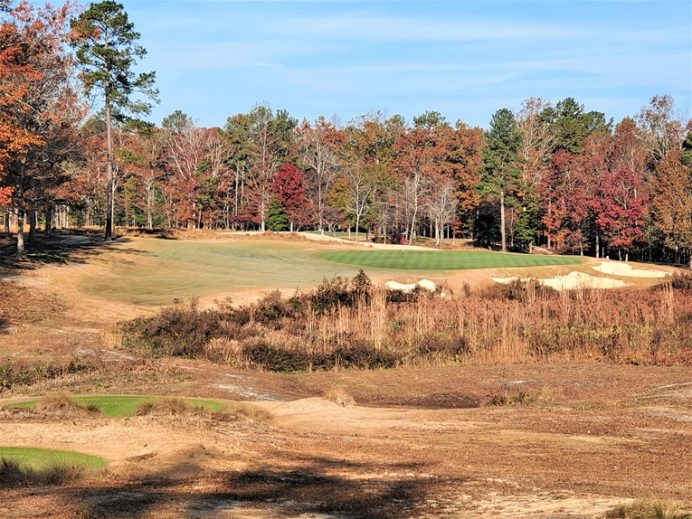
A rugged, attractive hole, the long one shot 7th gets progressively more testy as the hole location moves right. Balls that hit the bank left of the green release to the middle of the green but brave is the man who chases after back right hole locations.
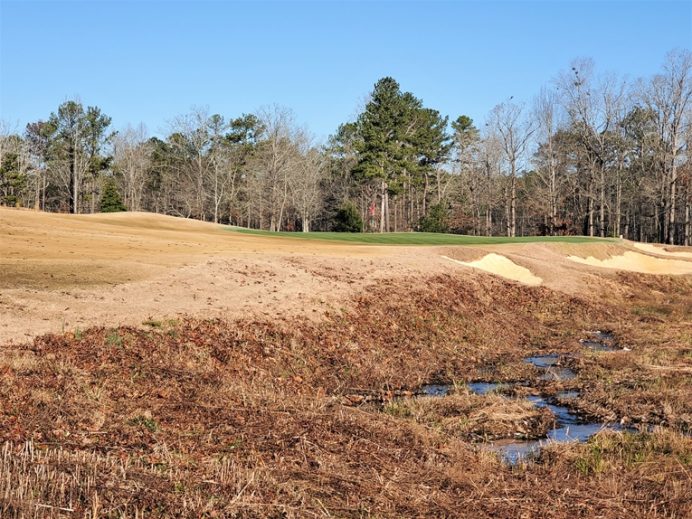
This view from 60 yards short left highlights the short grass and mounds that are the thinking golfer’s friends.
Eighth hole, 490 yards; The longest two shotter on the course required no bunkering either off the tee or by the green, such is the benefit of a Bill Coore routing. There is a solitary 50 yard long bunker 160 yards from the green that must be negotiated if one’s tee ball goes awry but otherwise, this hole hammers home the appeal of golf as a ground game sport. As previously noted, the green itself is a marvel, glued to the ground and able to receive shots that initially land as far away as 35 yards high right. Playing a lengthy approach into it and watching for nearly twenty seconds (!) as the ball releases off the slope and ambles across the putting green recalls similar moments from Kapalua. Such recollections become long term memories because of how unique the shots are (especially in America) and how long they take to unfold. While attacking a tight hole location by carrying a greenside bunker has its own merit, such shots play out on thousands of courses world-wide. Bunkers come in all shapes and sizes but a bunker is a bunker is a bunker. Landforms are more distinctive and holes that play off the land are therefore more distinctive.
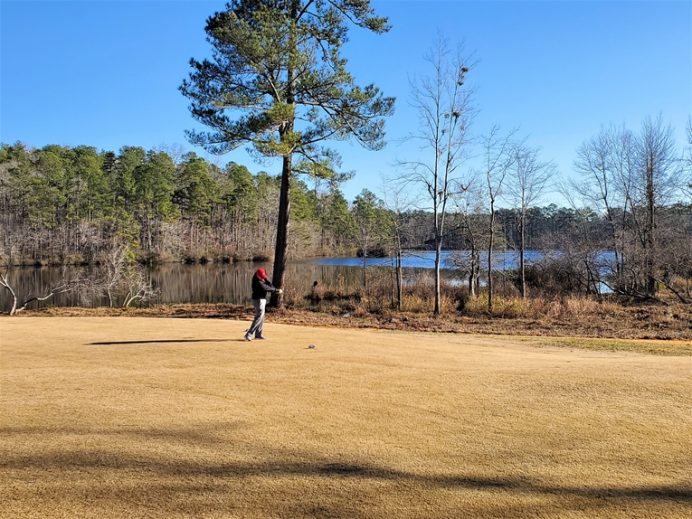
The closest two points to the lake at 8 are the tee and green. Otherwise, Coore made a beeline for the higher ground which he felt would offer the best golf.

The view from the tee provides little comfort. A high draw that carries the crest of the hill releases far enough to bring …
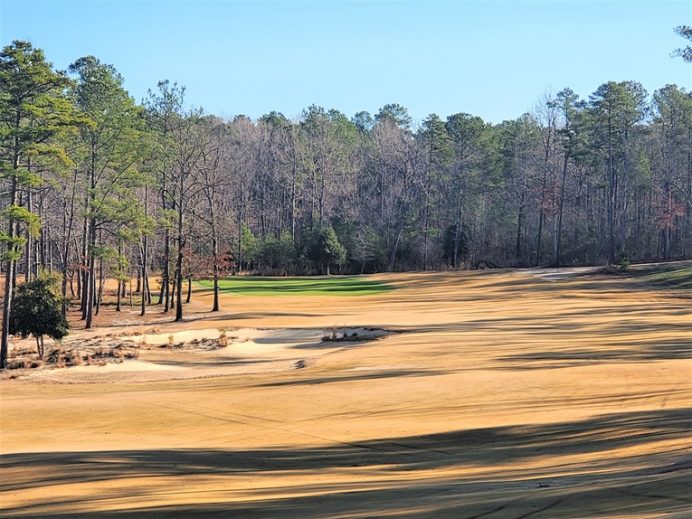
… the green in reach for one’s second. The long approach is actually one of the day’s most rewarding shots as a ball that hits the hill right of the green will slowly trundle down onto the putting surface.

This man’s approach didn’t quite have enough umph and ran out of gas on the hillside. A few more yards and he would have been comfortably on in two. As it was, he could get the chip shot no closer than 20 feet past the hole and had to settle for bogey. Such is the razor’s edge at Dormie.
Dormie Club
North Carolina, United States of America
Tenth hole, 655 yards; A reviled hole, this never-ending three shotter is as polarizing as any hole Coore & Crenshaw have ever built. For some, it ruins their enjoyment of a round at Dormie and because it messes with people’s heads to such a degree, the author likes it in its current form. What is meant by ‘current form’? Three versions of this hole have existed in its ten year life. The hole has always swept left from on high to down low by the lake. The sole issue – and the entire root cause of so much venom – has been to what extent a finger of the wetland protruded into the fairway. Initially, Coore & Crenshaw staked out the fairway around the county’s delineating wetland. Fifty-five yards of fairway existed from the wetland to the right edge of the rough (i.e. plenty of room for all players to skirt around the wetland without a forced carry). After Coore & Crenshaw left, the state came back and said no, the wetland had been compromised and needed to extend twenty-five yards farther right. The strip of fairway around the wetland was almost reduced in half, making it too narrow. Therefore, the tenth ceased to function properly for several years. Ultimately, the state allowed some fairway to be reclaimed and to the author, today’s hole plays fine, even though it remains quite taxing. A few points: 1) today’s hole is not how Coore & Crenshaw designed it, 2) the tee ball has always been a fine one, 3) the front to back green is among the course’s neatest putting surfaces. Many golfers end up within 20 to 70 yards of the green in regulation only to see their pitch release to the green’s back right. Not being accustomed to front to back greens, their first putt from ~65 feet often times come up ~12 feet short as they continually underestimate the effect of the slope. The resulting double bogey – and that’s after intelligently skirting the wetland – proves irksome to the point where some never mentally recover. Hitting a forced carry second shot from a downhill lie over a wetland is emphatically not what Coore & Crenshaw stand for. Let that rankle your opponent, not you.
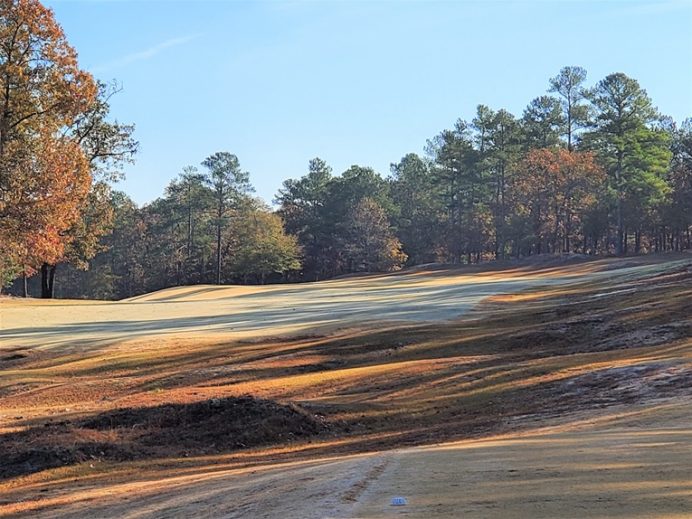
The tee shot has always been appealing as it is played to a fairway that bends left before …

… cascading downhill toward a finger of wetland. Today, nearly 40 yards exist between the wetland and the right edge of the fairway, which is sufficient room to allow people to navigate around it without having to attempt a 210 yard forced carry from a squirrelly downhill stance.
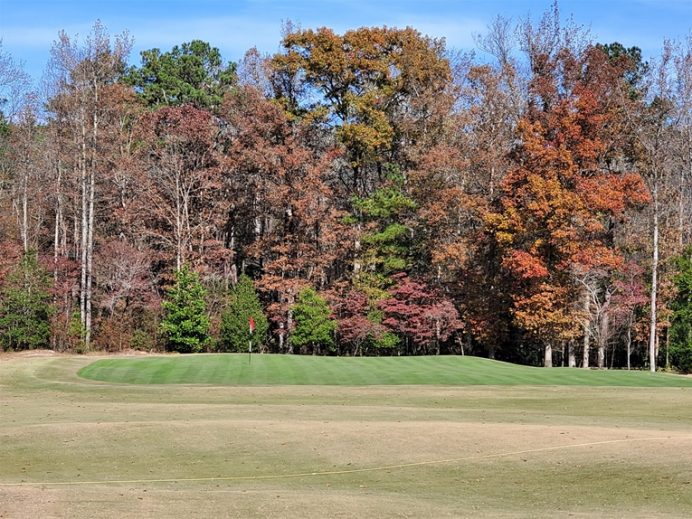
The green is the second largest on the course at over 8,875 square feet and is rife with character. Lewis notes with a smile that ‘it is one of the most harmless looking evil greens you will ever play.’
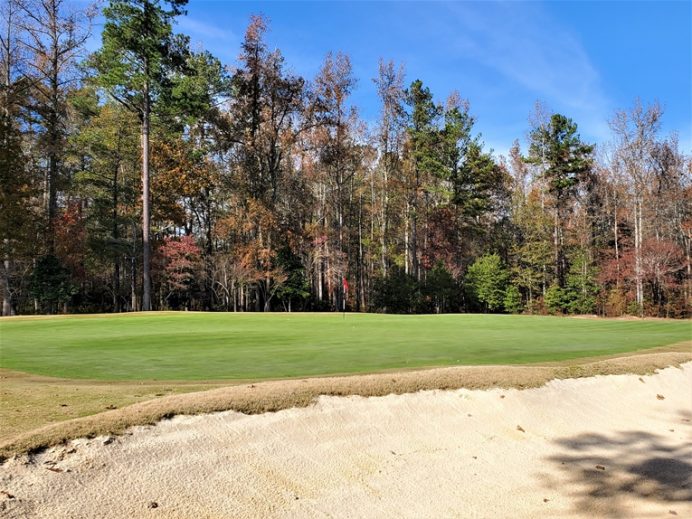
As seen front right, ‘rail’ contours add playing interest and create a lower back right pocket.
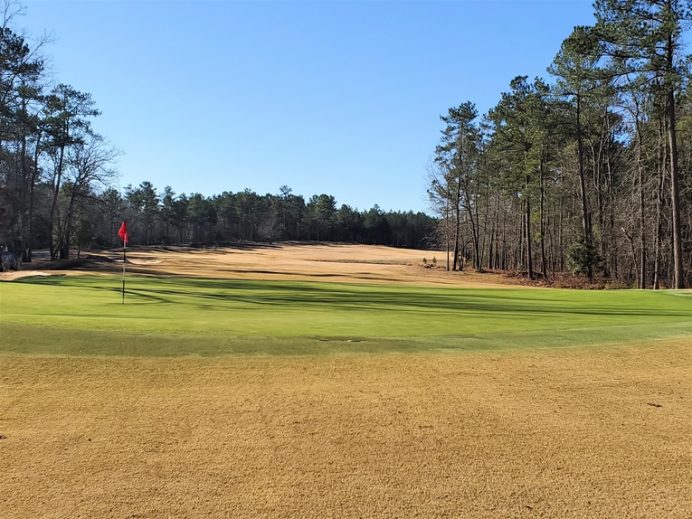
Just as with the par 5 6th , the green continues in the direction of the land, which is to say that it runs away from the player.
Twelfth hole, 115 yards; This ‘touch of poetry’ comes among the beating administered by the bruisingly long seventh, eighth, tenth and thirteenth holes. Some consider it their favorite hole on the course and it has certainly seen more that its share of hole-in-ones. A lack of length allows an architect to get saucy at the green, which is precisely what Coore & Crenshaw did. The range of moods one sees on the next tee is comical – and telling. Someone has likely birdied the hole and is chirping away while another nurses a truculent demeanor.
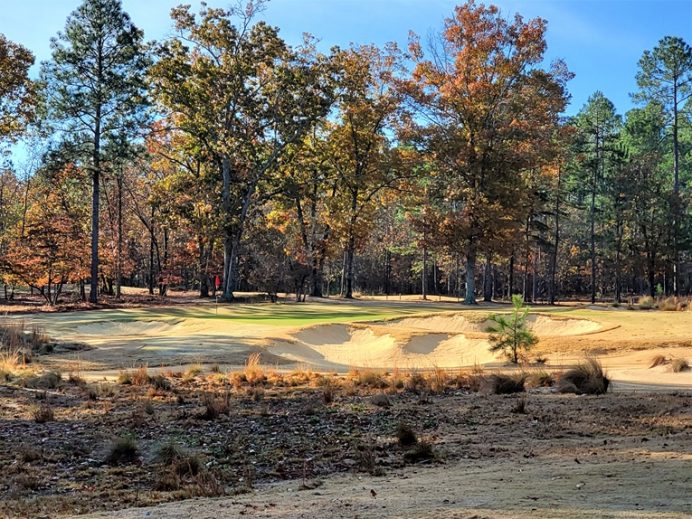
From 4 at Lost Farms in Tasmania to 17 at Clear Creek Tahoe to 11 at Hidden Creek in New Jersey, Coore & Crenshaw have produced short one shotters that tease and infuriate. The 12th’s idyllic charms on this autumn day are on full display. What isn’t as evident are the bold green contours.
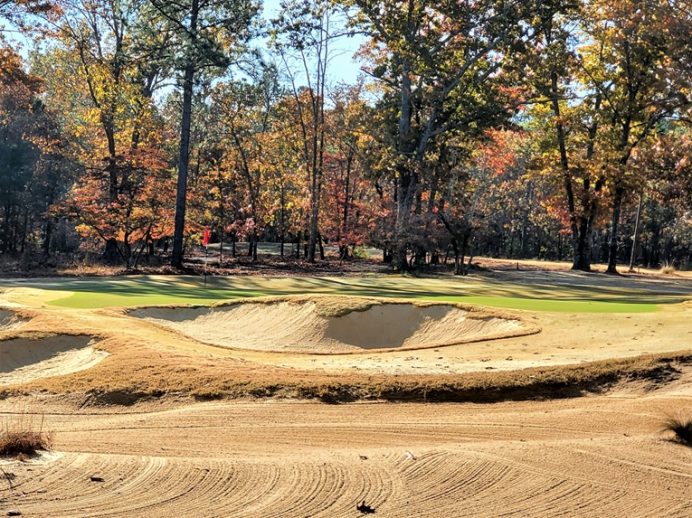
Given the hole’s uphill nature, much of the putting surface is obscured from the tee. Even this view from 50 yards short reveals little.
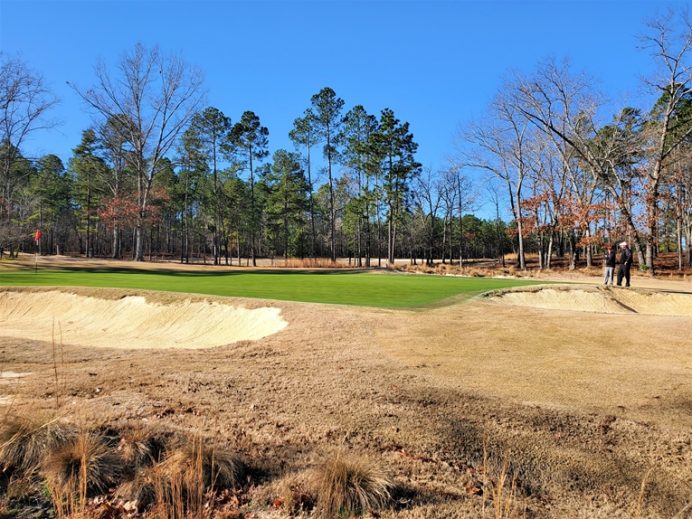
This view from the left indicates how the putting surface is high along the right and back left with a false front left.
Thirteenth hole, 490 yards; Other than ‘discovering’ this hole in the routing process, little was required for the architect to do other than show restraint. And that’s a lot harder than it sounds. The original founding vision of Dormie was as a high end private club that would attract members to travel here from the eastern half of the country. To do so, the golf needed to be compelling. To the author, lay of the land holes are but others prefer more eye-candy. Thankfully, Coore & Crenshaw eschewed the lazy way out of adding frilly bunkers while firmly placing the spotlight on the fine landforms. Similar to the eighth, an approach shot of length makes the ground game options sing as both greens are far more fascinating to approach by banking in some sort of hybrid than merely flying a short iron into the middle of the green. A design point worth emphasizing is that the four longest two shotters at Dormie (e.g. the fourth, fifth, eighth, and thirteenth) all feature enduring ground game options that make the four holes fun to play.

England is the author’s favorite country for golf in part because the Colts and Fowlers and Hutchisons never dolled up the land with extraneous, man-made features. That same design ethos is wonderfully applied here too.
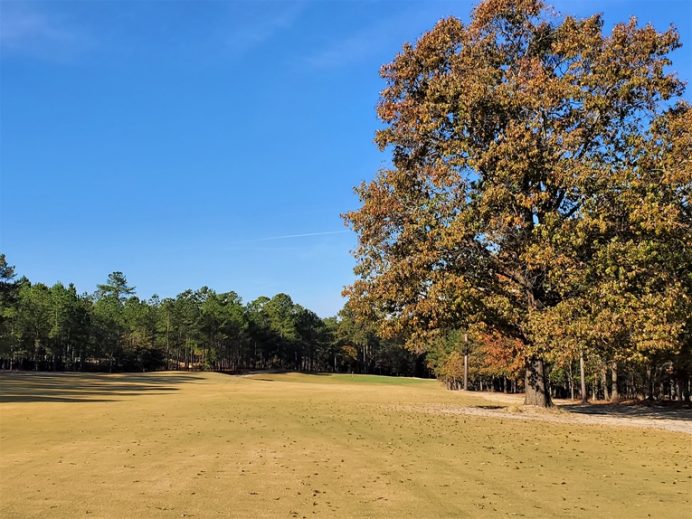
Dormie isn’t north of Oakhurst, it is north of Pinehurst, and this specimen oak is a feature not often found on the area golf courses. Coore shrewdly incorporated it into the playing of the hole as the slight left to right tilt of the fairway is enough to send tee balls toward it. This oak is just another feature that gives Dormie its own voice.
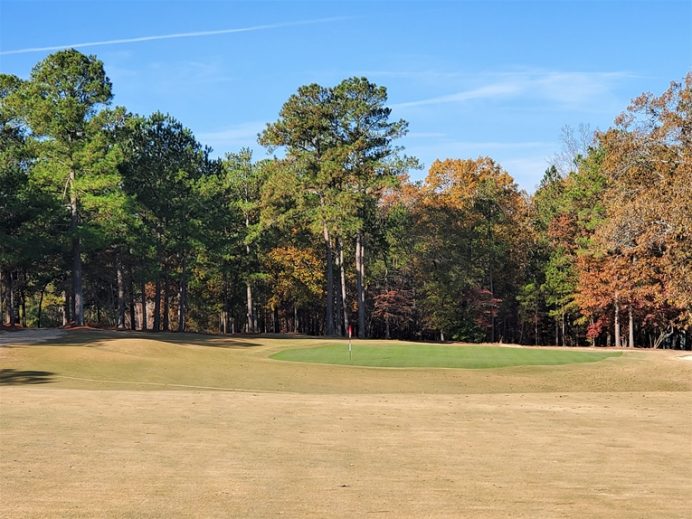
The beauty of simplicity resonates on the approach. Once again, look to the green’s high side for an optimal way to run an approach shot on. The playing aspects of the dormant Bermuda as cultivated by Green Keeper Lewis allow the hole to play to perfection.
Fourteenth hole, 300 yards; Another less is more hole. Though the fairway is wide and bunkerless, it calls for one of the day’s most precise tee shots. Similar to the last hole whereby the left to right cant of the fairway shunts the tee ball to a disadvantaged position (in the case of the thirteenth, behind the oak), this tilted fairway also thrives in feeding a tee ball into a materially worse position. The solitary greenside bunker comes into play more and more as the golfer allows his tee shot to drift right. Visually not as dynamic as many of the other holes, a cadre of locals nominate this deceptively difficult teaser as their favorite. Like the short 3rd, this hole is made by its green which, as seen in the photograph below, is higher in the front than the back and it follows the tilt of the land. An approach that lands a little long and right of the hole location seen below can be seen exiting the green to the right beyond the bunker.
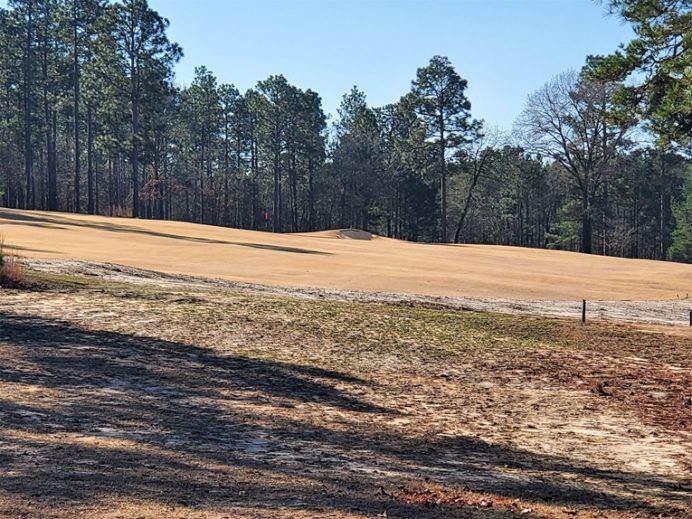
Stretching 62 yards from side to side, the 14th fairway seems void of golfing virtue.
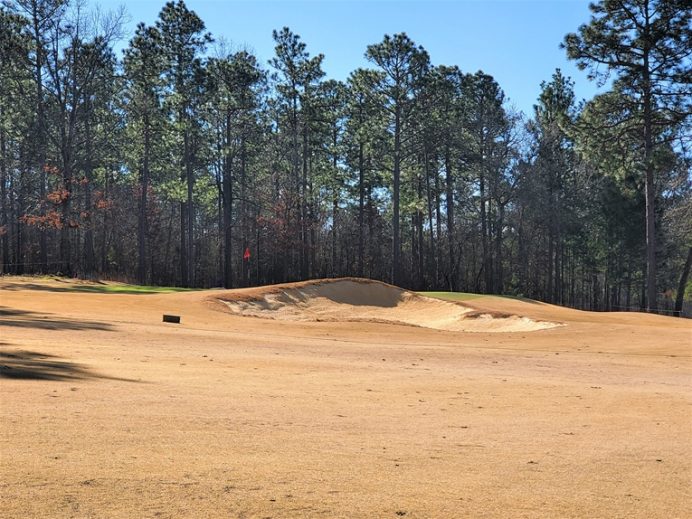
Nothing could be further from the truth. Look at all the divots – the right half of the fairway is a popular spot to end up, which means the golfer has to carry the bunker and approach the narrow green from an oblique angle.
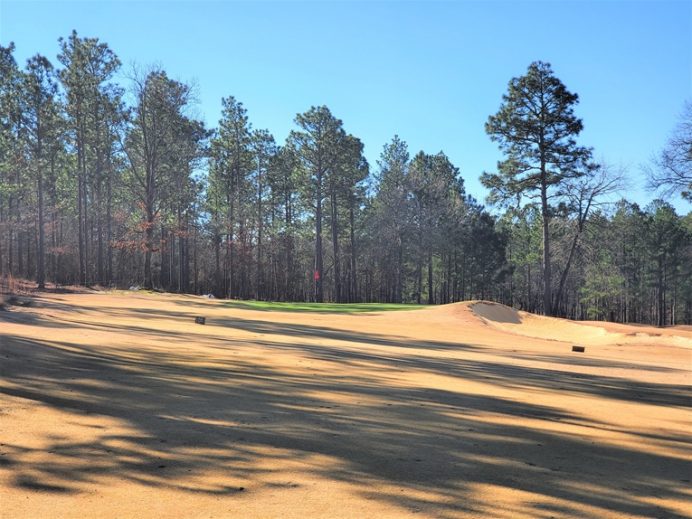
Far more advantageous to approach the green from the high left center. Only from here does the golfer see much of the putting surface and hit down the axis of the green.
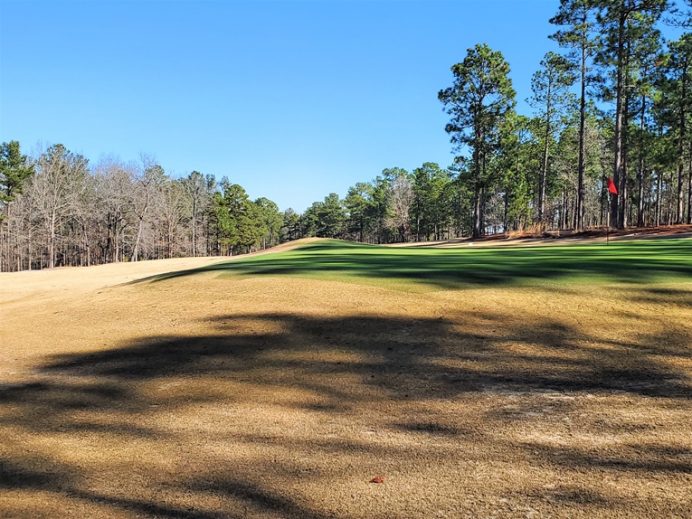
This view from behind shows the third and final green at Dormie that slopes from front to back. Under 3,900 square feet, this is also the smallest target the golfer faces all day.
Fifteenth hole, 380 yards; A special hole, the fifteenth features one of Pete Dye’s favorite ploys, namely a fairway that runs diagonal to the tee. The fierce hazard in the form of a wetland appears a daunting carry but again, Coore & Crenshaw let you do so with the ball perfectly placed on a tee. Plus, the cant of the fairway is such that the real aim is toward the pair of distant bunkers from where the ground contours will shunt the ball right and into good position.
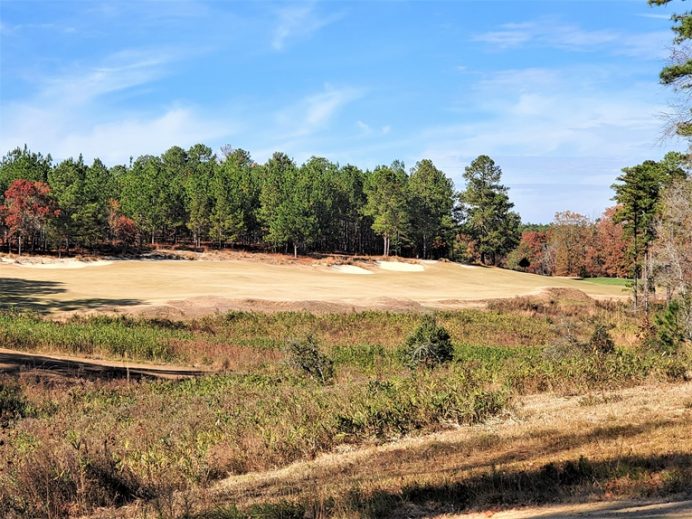
Don’t let the sight of the green to the right woo you into being too greedy off the tee. Better to aim at the pair of distant bunkers and let the ground do the work.
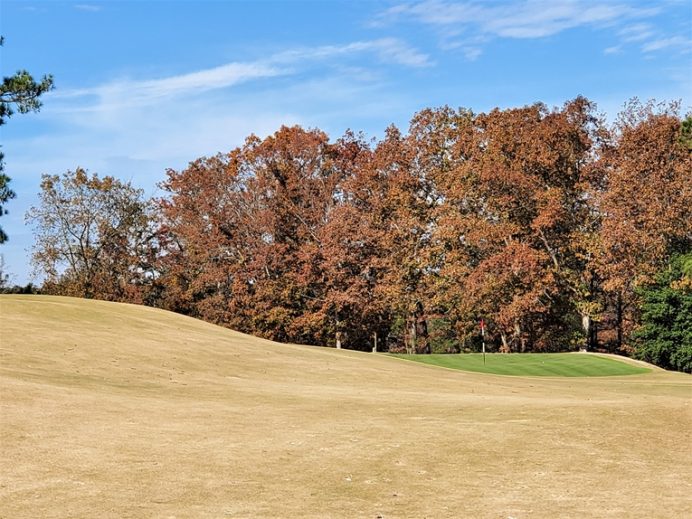
Ultimately, it is important that the player end up in the right center of the fairway. Otherwise, the left hill obscures a view of the green.
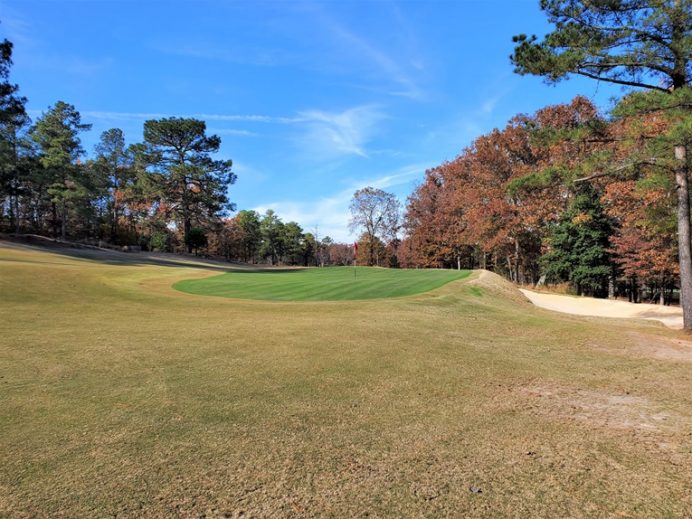
The course’s deepest greenside bunker is to right but given the bank and short grass left, the player should never visit it.
Sixteenth hole, 200 yards; The first five holes built and open for play were four, fifteen through eighteen. It made for an extremely fine loop in the early days and exposed potential members to some of the best features and holes. If you didn’t like those holes, you weren’t going to join! All five holes enjoy some of the best detail work on the course. The property’s similarities to Pine Valley manifest themselves at the sixteenth as the combination of hardwoods, pines and sandy soil conspire to present a portrait of pure golf.
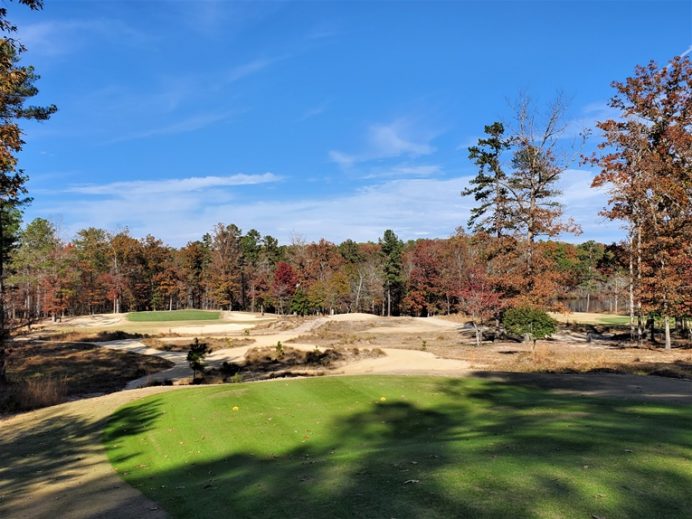
Postcard perfect, one aspect of the 16th that is overlooked is how well it compliments the other one shotters. There is the tilted 7th, the back to front slopes at the 9th and the wild interior contours of the 12th. Meanwhile here a Perry Maxwell type ‘puff’ appears in the green’s center, meaning that the middle is the high point of the putting surface, in stark contrast to the other three greens. As Pete Dye liked to say, variety, variety, variety!
Seventeenth hole, 495 yards; Once the Dormie project was announced in 2005, this was the exact sort of hole that the author hoped would emerge. Why? Because it is the only type hole – a gambling par 5 – that Pine Valley lacks. A forty yard deep cross bunker walls off the fairway before it then stair-steps up to a higher level. The penultimate hole’s challenge boils down to getting past this great hazard in two and then keeping one’s approach below the hole on what is the course’s steepest pitched green.
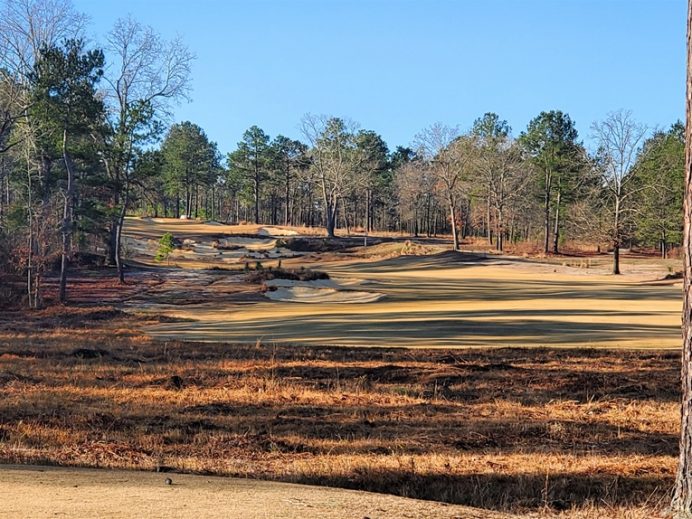
The curve of the fairway as it bends left and heads uphill is a sight to behold; the site’s full potential is realized.
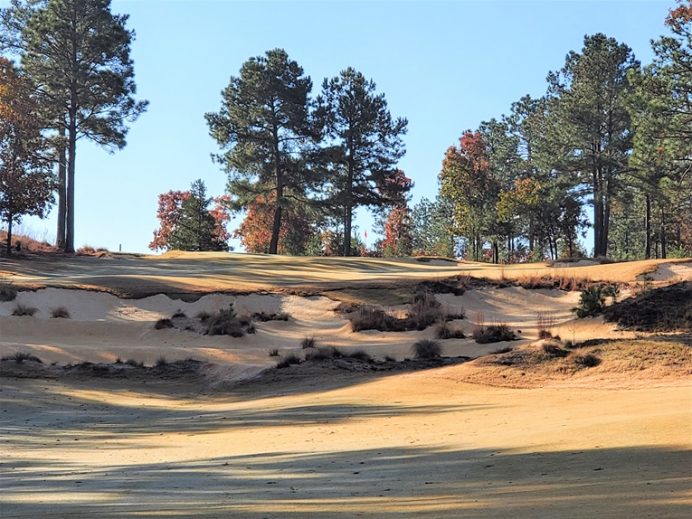
A big drive presents the opportunity to carry the South’s version of Hell’s Half-Acre and reach the green in two.
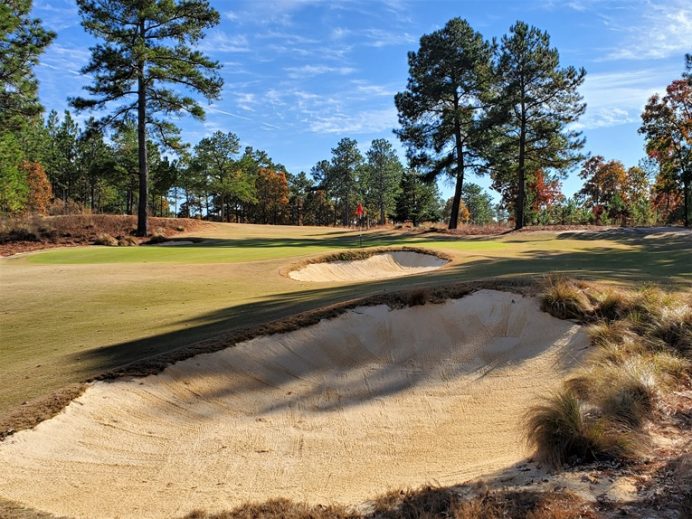
Why study golf course architecture? One reason is to reduce your score! The sight of an uphill Coore & Crenshaw green blares at the student to be on full alert as the green will follow the land and be steeply pitched from back to front. That knowledge serves the golfer well at Dormie’s three most uphill approaches, namely 3, 12 and 17. All three are excellent positional holes.
Eighteenth hole, 420 yards; Underrated, the Home hole epitomizes the course in many ways. The fairway appears wide because it is (!) but the high left is far preferable than the right third which dips and peels right and away from the green. A comparably hit tee shot with a draw might end up forty yards (!) closer to the green than one hit with a fade that gets shunted right. Draping the fairway over the land in such a manner is one of the things that separates Coore & Crenshaw from all but one other design firm. Coore’s ability to route and ensnare such a feature into the how the hole plays is truly of exception. Just imagine having 1,200 acres at your disposal and spotting this subtle slope and incorporating it into a hole so well. Coore & Crenshaw didn’t move a scintilla of dirt in the fairway and yet the hole is engrossing off the tee. The approach is full of allure to a green that caps off a sterling collection of eighteen putting surfaces. Indeed, the greens here are so good and diverse that the author puts the set in Coore & Crenshaw’s all-time top 5 sets.

The native grasses and vegetation have always meant that Dormie enjoyed great texture. Here at 18, Coore uses the native fescues to hide the preferred left side of the fairway.
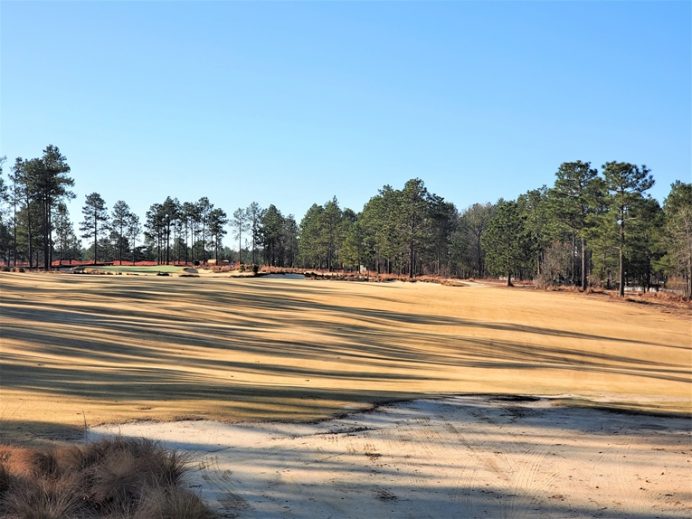
Only once the golfer reaches the fairway do the sights of the green to the left and the fairway sliding away right fully reveal themselves.
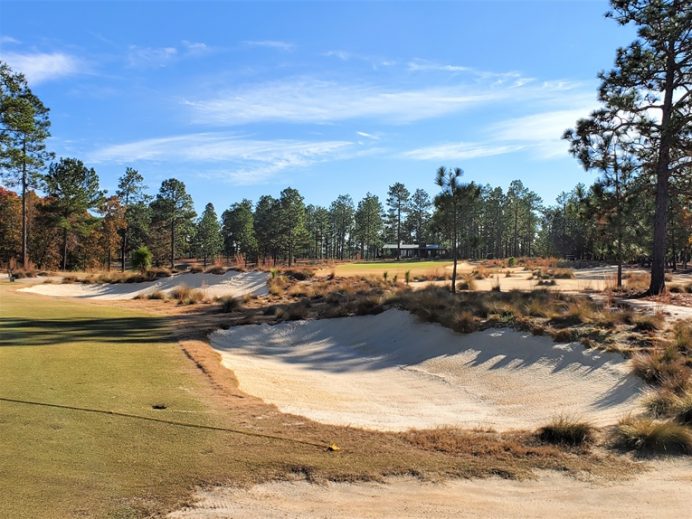
Formalized cross bunkers and an exposed sandy expanse bisect the fairway 150 yards from the green, essentially creating an island fairway off the tee.
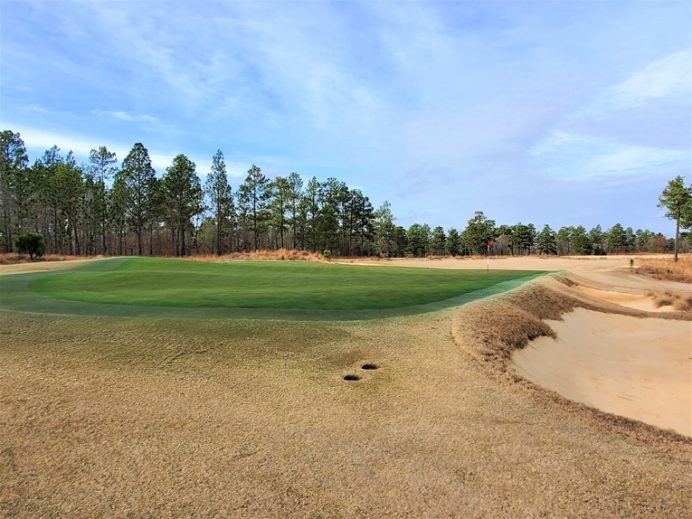
This view from behind captures the rolling ‘sea waves’ found within the green’s right portion. Fifty-two paces long, this is the deepest green on the course and Lewis notes that back hole locations can add two clubs for one’s approach.
All the ingredients for good golf – unspoiled land, sandy soil, hardwoods, rolling topography – were present. True, the wetlands made it a challenging proposition to create a walkable course and thank goodness the original owners had the foresight to hire Coore & Crenshaw. After nearly 100 rounds played here, the author finds it hard to imagine that a finer collection of holes could have emerged. Since Donald Ross’s death in 1948 until 2005, the author contends that the greatest thing to have happened in Moore County golf-wise was the arrival of Coore & Crenshaw for this project. Not only was this the finest course built in the area since Ross’s passing, it established a more authentic approach to design that embraced the philosophies from the Golden Age of Design. Instead of introducing the lakes into play like so many of the courses built here from 1970-2000, it played away from such features. Dormie incorporated far less shaping than all the courses built here in the modern age and it all adds up to better playing experience with man cocooned in nature.
Dormie as a club had a rough beginning. Originally created as private club with a six figure initiation fee and a housing component around the course’s perimeter, those aspirations crumbled in the wake of the 2007/2008 financial recession. When the recession hit, course construction was suspended for over a year. The last three holes built were the first three. Play commenced in the fall of 2010 with Dormie open to outside play. The only thing that it held it together where the people who worked here, especially its Green Keeper Billy Lewis, and the quality of the golf. Lewis did a phenomenal job stretching a thin budget by focusing his attention and available resources to insuring the playing surfaces released the ball as quickly as possible. His approach dovetailed perfectly with Coore’s lay of the land architecture and created a unique playing experience in the area. Happily, Lewis is here to this day, which portends well for future golfers. If the golf had been indifferent, the course would not have survived. Indeed, Coore has always noted that, ‘It’s a survivor course, which must mean that people enjoy it.’ Survive it did and in 2018 a new entity, soon thereafter to be called the Dormie Network, purchased the course and the hope is that the course will soon realize its full potential.
For the reasons articulated throughout this profile, the author considers Dormie to be an underrated design gem. Even within Coore & Crenshaw’s own body of work, I place it quite highly, largely because of its emphasis on the ground and its greens. True, it could be better. The eleventh hole never fully materialized and the detail work on holes one and two is lacking compared to the ones built early like sixteen and eighteen. Though the course opened in 2010, the walk in February, 2020 remains far from perfect as too many times the golfer is unable to proceed down the hole but rather has to zigzag into the woods on a cart path to cross a wetland and emerge on the far side. Thankfully, walking bridges are slated to be added to the second, fifteenth and seventh holes in the summer of 2020. Also, ground has been broken for a modern clubhouse, which sends a clear message that Dormie Network is here to stay and invest capital to enhance the overall playing experience. With a routing this exceptional and greens this good, the author cannot help but think more and more people will soon appreciate the golf before them once the finishing touches are applied.
After Dormie, Coore & Crenshaw went on to re-establish Pinehurst No. 2 as a world top 20 course in preparation for the back to back men and women’s U.S. Opens in 2014. In turn, Mid Pines and Pine Needles then raised their game with first-rate restoration projects as well. Soon thereafter, the Pinehurst Resort brought in Gil Hanse to build the Cradle, the Thistle-Du putting course and Pinehurst No. 4. The area has been a stunning run of successes – and it started with Dormie.





![The Park, West Palm (Lit 9) [2023]](https://golfclubatlas.com/wp-content/uploads/2024/12/IMG_7092-2-scaled-500x383.jpg)


